 At the end of June Shannon had a Deloitte Conference in Athens, Greece, making it a good reason to extend the invitation to myself and thus create a vacation out of it! While Shannon attended his conference for a few days, I became acquainted with the ancient world of Athens. When his conference was finished, we ventured out to a few areas outside of Athens including Delphi and two popular Islands, Mykonos and Santorini (Sorry in advance for the long blog and photo shoot!)
At the end of June Shannon had a Deloitte Conference in Athens, Greece, making it a good reason to extend the invitation to myself and thus create a vacation out of it! While Shannon attended his conference for a few days, I became acquainted with the ancient world of Athens. When his conference was finished, we ventured out to a few areas outside of Athens including Delphi and two popular Islands, Mykonos and Santorini (Sorry in advance for the long blog and photo shoot!)We first visited The Temple of the Olympian Zeus which was a short walk from our hotel in Athens. Though only a few columns remain of the Temple of Olympia Zeus it does not take much imagination to realize that this was one monster of a building! Here are some facts: The building of the Temple of Olympian Zeus actually began in the 6th Century by Peisistratos but work was stopped either because of a lack of money or because Pisistratus's son, Hippias, was overthrown in 510 BC. The temple was not finished until the Emperor Hadrian completed in 131 AD, seven hundred years later. There were other attempts to continue the building. The Classical Greeks (487-379) left it unfinished because they believed it was too big and symbolized the arrogance of people who believed they were equal to the Gods. During the Third Century when the Macedonians ruled Athens work was begun again by Antiochus the IV of Syria who wanted to build the world's largest temple and hired the Roman architect Cossotius to complete the job, but this ended when Antiochus died. In 86 BC, during Roman rule the general Sulla took two columns from the unfinished temple to Rome for the Temple of Jupiter on the Capitoline Hill which influenced the development of the Corinthian style in Rome. Originally there were 104 Corinthian columns of which only 15 remain standing. One of the columns actually blew down in a storm in 1852. Hadrian had erected a giant gold and ivory statue of Zeus inside the temple with an equally large one of himself next to it. Nothing remains of these statues. It is not known when the temple of Zeus was destroyed but it probably came down in an earthquake during the medieval period.
While we were in Athens we saw several sites with the most astonishing being The Acropolis. Here are some facts to help you understand the greatness of it. The term Acropolis means upper city and many of the city states of ancient Greece are built around an acropolis where the inhabitants can go as a place of refuge in times of invasion. It's for this reason that the most sacred buildings are usually on the acropolis which is normally the highest point of the city. The one in Athens is the best known of them all, and is therefore often referred to as "The Acropolis". Towering over the capital, it is quite an impressive sight. Walking around on its grounds, it gives the visitor a feeling of awe and a true sense of the greatness of the ancient Greeks. The Parthenon and other main buildings on the Acropolis were built by Pericles in the fifth century BC as a monument to the cultural and political achievements of the inhabitants of Athens. It took 9 years to build and was completed in 438 BC and is one of the most recognizable structures in the world. From a temple it became a church, a mosque and finally as a storage facility for Turkish gunpowder. Due to the bombing in 1687 by the Venetians, restoration has been going on for the last 30 years and may go on for another 30! The Erecthion sits on the most sacred site of the Acropolis where Poseidon and Athena had their contest over who would be the Patron of the city. Athena was declared the victor and the great city of Athens was named for her while Poseidon was given a small village in Syros. The building itself contains the porch of the maidens or Caryatids which are now copies, four of which have been placed in the Acropolis museum, hopefully to be reunited with a fifth taken from the Acropolis by Lord Elgin and put in the British Museum more than a century ago.
Below the Acropolis is the theater of Herod Atticus built by the Romans in 161 AD and still used today for concerts. Further on is the Theater of Dionysious the first stone theater and home to Sophocles, Aeschylus, Euripides and Aristophanes. It was rebuilt around 342 BC by Lykourgos and then enlarged by the Romans to be used for gladiator fights.
Another small temple known as the Thission can be seen from The Acropolis a short distance away. It was built in 449 BC and is virtually still intact. Supposedly named for Theseus because his exploits were shown on the frieze, it is now believed that it was actually a temple to Hephaestos and Athena. Unfortunately they realized their mistake too late and the entire neighborhood is called Thission. The temple was used as a Church.
We also visited Delphi, the site of the famous oracle. As we were riding the tour bus through the winding mountains to Delphi, we saw several olive trees growing wild on the hill slopes and in the valleys... I just wished they were ripe because I have turned to loving olives these days (hence the reason why we have an olive tree in our apartment)! Anyway, back to the facts... The Ancient Greeks believed Delphi was the center of the earth. Several pilgrims traveled here from 9th century BC to seek divine direction in matters of war, worship, love or business up until 391 AD, which is when the oracle ceased. The sanctuary site was rediscovered towards the end of the 17th century and at that time Archeologists began the excavation process. A theatre was revealed which was thought to have been built around the 4th century BC with a capacity of 5,000 people. It was thought to be associated with Dionysos, the god of ecstasy, the arts and wine, who ruled Delphi during the winter when the oracle was silent. A path leads up through cool pine groves to the stadium (5th century BC) which contains stone seats for 7,000 people. The Delphi site also contained several Treasury Houses, but only 1 or 2 have been restored. There is also a museum nearby which shows all the stone, bronze and gold statues that were once a part of the site.
Next we were off to some fun in the sun in the Islands of Mykonos and Santorini! They are both situated in the group of Islands called 'The Cyclades' off the coast of Greece. We were surprised with the lack of vegetation on the Islands since they were mostly rocky and contained low shrubs with a few palm trees and bamboo, but still very cool to see. Most of the buildings on the islands were white with blue shutters or rooftops along with churches with blue domes.
Mykonos is known for its maze of narrow streets, Little Venice, beaches, numerous windmills and least but not last, it's wild nightlife. We had fun hanging out at the beach under a palm leaf umbrella with our lounge chairs and some foo-foo drinks. It was extremely windy when we were at the beach, but that didn't stop us from enjoying the crystal clear and refreshing ocean water (minus the salt)! The only downside to the gleaming sun was Shannon's polka dotted sunburn (very painful so he says), which was the result of my failure to rub in the spray-on sunscreen I squirted him with.
After spending 2 nights in Mykonos, we left for Santorini (also known as 'Thira' during the BC era) for another 2 nights. We actually preferred Santorini since we thought it was even more beautiful than Mykonos. Santorini is essentially the remnants of a former volcano after it erupted in 1647 and 1628 BC. The island's heart sank below the sea leaving a crater (caldera) 10 km in diameter, giving the island its current crescent moon shape. It's quite amazing when you first enter the island by the ferry since huge reddish-brown and black and grey cliffs rimmed with towns seem to rise up and clamp around you giving one an awesome view. Santorini still has an active volcano at the center of the caldera; people can take a ferry to see it. There are even hotspots where visitors can go for a swim. We also did some touring of the cute little towns of Fira and Oia along with visiting the black sand/rock beaches. Furthermore, we visited the remains of the Minoan civilization from 3000 BC which was mostly wiped out by the volcano mentioned above. We also tried some wine from Santorini since it is considered one of Greece's most important producers. Santorini is supposed to have amazing sunsets, so we made sure to take in one of those as well, but I still think Nebraska's are pretty dam good!
Temple of Olympian Zeus

Hadrian's Arch - infront of Zeus's Temple

Temple of Zeus (grounds) - more photos later since we saw it twice

Athen's Parliament: Changing of the Guards

Athens is Flea Market Heaven!

On a small mountain top near The Acropolis overlooking Athens

The Parthenon (located on the site of 'The Acropolis')

Old Byzantine Church (I think)

.jpg)
Another Byzantine Church

My friend, Kassi, from Athens who I met Studying Abroad in England in 2001 (we met up one night and had a fabulous Greek dinner!)
.jpg)
Temple of Apollo at Ancient Delphi

Temple of Apollo with the mountanious surroundings

4th Century BC Theatre

5th Century BC Stadium
 Overview of Theatre and other ruins of Delphi
Overview of Theatre and other ruins of Delphi Temple of Apollo up close
Temple of Apollo up close Treasury House at the site of Ancient Delphi
Treasury House at the site of Ancient Delphi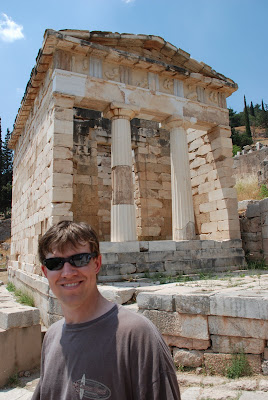 Delphi ruins - site of the famous oracle
Delphi ruins - site of the famous oracle.jpg) Look at all those yummy olive trees!
Look at all those yummy olive trees! Where we ate lunch after touring Delphi's ruins
Where we ate lunch after touring Delphi's ruins National Libray (Back in Athens)
National Libray (Back in Athens) University of Athens
University of Athens University of Athens
University of Athens Academy of Athens
Academy of Athens Academy of Athens - check out the ornate stone statues
Academy of Athens - check out the ornate stone statues Off to the Greek Islands! Our boat ride to Mykonos took around 5 hrs
Off to the Greek Islands! Our boat ride to Mykonos took around 5 hrs Blue domed church on the coast of Athens
Blue domed church on the coast of Athens Pyros (our boat made a quick stop at this island before heading to Mykonos)
Pyros (our boat made a quick stop at this island before heading to Mykonos) Pyros
Pyros Pyros
Pyros Mykonos
Mykonos Mykonos (notice all the white houses with blue shutters - classic Greece)
Mykonos (notice all the white houses with blue shutters - classic Greece) Mykonos - overlooking bay
Mykonos - overlooking bay.jpg) Classic Mykonos windmill
Classic Mykonos windmill Maze of village pathways lined with shops, hotels and restaurants
Maze of village pathways lined with shops, hotels and restaurants Waterfront called 'Little Venice' in Mykonos
Waterfront called 'Little Venice' in Mykonos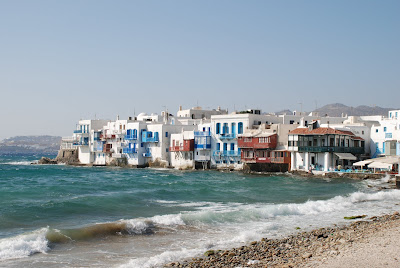 Mykonos is known for its old windmills
Mykonos is known for its old windmills
White, snow-capped looking church
 Mykonos with windmills in background
Mykonos with windmills in background Another white chalk-like church
Another white chalk-like church This time a little variety, RED doors vs BLUE!
This time a little variety, RED doors vs BLUE! Infront of Mykonos's famous windmills
Infront of Mykonos's famous windmills Shannon being creative, trying to capture Little Venice one more time!
Shannon being creative, trying to capture Little Venice one more time! See I told you it was windy on this Island!
See I told you it was windy on this Island! More windmills
More windmills Row of windmills
Row of windmills Having a tropical drink at a bar in Little Venice
Having a tropical drink at a bar in Little Venice Our hotel in Mykonos (notice the rocky terrain of the Island, not what I expected)
Our hotel in Mykonos (notice the rocky terrain of the Island, not what I expected) Mykonos Beach (a few nudists out there!)
Mykonos Beach (a few nudists out there!) Our fast speed boat which transported us to Santorini
Our fast speed boat which transported us to Santorini Santorini
Santorini Santorini - notice how it's in the shape of a crescent moon due to the massive caldera (crater) which occurred after a volcano erupted here several thousands of years ago
Santorini - notice how it's in the shape of a crescent moon due to the massive caldera (crater) which occurred after a volcano erupted here several thousands of years ago Santorini - walking along the rim of the caldera where most of its towns are located
Santorini - walking along the rim of the caldera where most of its towns are located.jpg)
Just another shot of the cliff
 Santorini
Santorini Long ways down there!
Long ways down there! Black pebble beaches of Santorini
Black pebble beaches of Santorini Sun umbrellas made out of palm tree leaves were everywhere, same with Mykonos (we dropped by early in the morning; hence no one was there)
Sun umbrellas made out of palm tree leaves were everywhere, same with Mykonos (we dropped by early in the morning; hence no one was there)
Hiking up the mountain to the ruins of Ancient Thira where the Minoan Civilization once thrived (Santorini)
 Ruins of Anicent Thira
Ruins of Anicent Thira In case you can't make the long haul back down!
In case you can't make the long haul back down! Old carvings in the rocks (lion and bird)
Old carvings in the rocks (lion and bird).jpg) More ruins
More ruins Top of the mountain where Ancient Thira once existed
Top of the mountain where Ancient Thira once existed More ruins
More ruins Beautiful white church - back in the town of Fira in Santorini
Beautiful white church - back in the town of Fira in Santorini
View of the town of Fira (taken on our long walk along the ridge)

Church bells
 The island in the back is actually the center of the caldera (crater) where people can still see signs of an active volcano, tourists swim in hotspots surrounding the small island
The island in the back is actually the center of the caldera (crater) where people can still see signs of an active volcano, tourists swim in hotspots surrounding the small island Rim of Caldera with huge cliffs
Rim of Caldera with huge cliffs Shannon with the caldera view
Shannon with the caldera view Shannon's artistic side!
Shannon's artistic side! Notice all the red crosses
Notice all the red crosses  Walkway down the cliff
Walkway down the cliff Oia - another town in Santorini
Oia - another town in Santorini More blue roofed churches
More blue roofed churches Typical blue and white church and surroundings
Typical blue and white church and surroundings On our walk through Oia
On our walk through Oia Shannon's artistic side again!
Shannon's artistic side again! Another blue-domed church in Oia
Another blue-domed church in Oia Classic blue-domed church in Oia
Classic blue-domed church in Oia Overlooking the Mediteranean
Overlooking the Mediteranean Olive Trees grow everywhere in Greece...they love the rocky soil (the rest of the photos were taken back in Athens)
Olive Trees grow everywhere in Greece...they love the rocky soil (the rest of the photos were taken back in Athens).jpg) Trying to find some ripe ones! (no luck though as we were too early in the season)
Trying to find some ripe ones! (no luck though as we were too early in the season) 'Panathinaiko' Olympic Stadium from the 1st Modern Olympics in Athens during the Summer of 1896
'Panathinaiko' Olympic Stadium from the 1st Modern Olympics in Athens during the Summer of 1896 Temple of Olympian Zeus
Temple of Olympian Zeus Temple of Olympian Zeus
Temple of Olympian Zeus Temple of Olympian Zeus
Temple of Olympian Zeus Two columns from Zeus's Temple, Hadrian's Arch (right) and The Acropolis (between pillars) in the background
Two columns from Zeus's Temple, Hadrian's Arch (right) and The Acropolis (between pillars) in the background One of the columns collapsed in 1852
One of the columns collapsed in 1852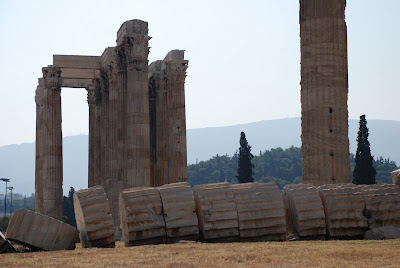 Standing on the site of Zeus's Temple with The Acropolis in the background
Standing on the site of Zeus's Temple with The Acropolis in the background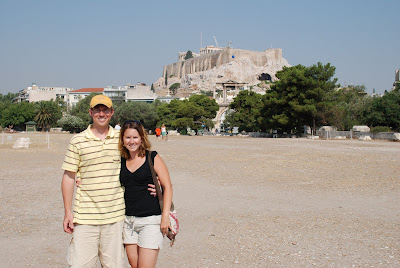
The Parthenon (on The Acropolis), is currently being renovated

The Parthenon

At The Acropolis with The Parthenon in the background
.jpg)
Theater of Herod Atticus - slightly below The Acropolis and still used for conerts occasionally

Theater of Dionysious - next to The Acropolis (the first stone theater)

The Erecthion sits on the most sacred site of the Acropolis where Poseidon and Athena had their contest over who would be the Patron of the city. Athena was declared the victor and the great city of Athens was named for her.
.jpg)
Columns from The Erecthion building

The Erecthion structure contains a porch of 5 maidens or Caryatids which are actually copies (four of which have been placed in the Acropolis museum, hopefully to be reunited with a fifth taken from the Acropolis by Lord Elgin and put in the British Museum more than a century ago).

The view from The Acropolis of The Temple of Zeus

Another small temple known as the Thission can be seen from The Acropolis (it's actually in better shape than The Parthenon)

Thission Temple

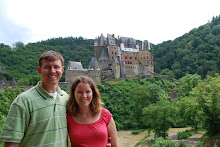

1 comment:
Pretty inspiring and well documented.
Thanks for sharing!
Post a Comment